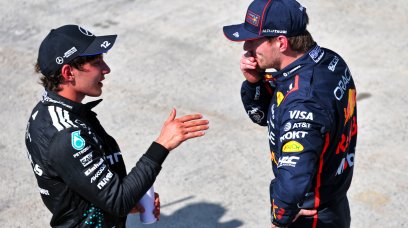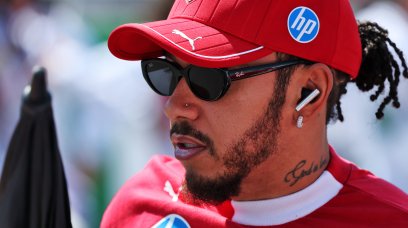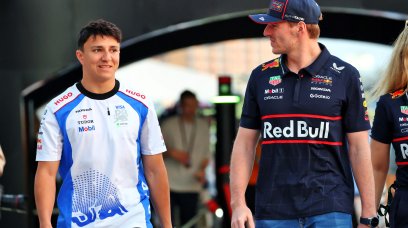Ask a group of ten different people who Formula 1's Greatest Driver of All Time is, and the chances are there will be ten different answers. It is a uniquely personal thing for someone with a variety of factors all playing into the decision. Perhaps you saw the driver you think is the 'GOAT' win a championship in person or were present for their most memorable drive. Maybe they are the national hero of your country or possibly it is an emotional thing where the way they made you feel when they raced connected. Whatever the reason, it is a debate that can be had until the cows come home, with the answer forever in abeyance owing to the massive changes Grand Prix racing has undergone from the days of Juan Manuel Fangio and Sir Jackie Stewart to the modern behemoth of Sir Lewis Hamilton or Max Verstappen. But, even in the ever-changing landscape of Grand Prix racing, there are a few traits that down the years remain unchanged and, in your humble writer's opinion, leads to a standout candidate to be considered F1's 'GOAT'.
Trait 1: Sustained success
This might seem fairly obvious, but to be considered F1's 'GOAT' a driver must come to define their era of Grand Prix racing. They must be seen and be known as 'the man to beat'. Plenty of World Champions over the years have gone toe-to-toe with the driver considered the yardstick and sometimes beaten them in one or two seasons, with perhaps Mika Hakkinen vs Michael Schumacher in the late 1990s, early 2000s the best example. The 1999 battle was ruined after Schumacher broke his leg at Silverstone, with Hakkinen having edged the German the year before in the winner-takes-all shootout in Japan. Come 2000, and it was Schumacher who regained his crown after another tussle as Hakkinen admitted he simply could not continue putting the amount of psychological effort year after year to go up against the robotic Schumacher. This was the start of the all-conquering run for Schumacher and Ferrari that lifted him from just a Formula 1 World Champion to the ranks of global sporting icon with the likes of Michael Jordan. To be considered as the potential F1 'GOAT', a driver needs a sustained period of success over a number of years where the questions in pre-season are 'can anybody stop XXX this year?' Pretenders to the throne must be dismissed eventually with the champion going out on their terms, at a time of their choosing, usually at the top.
Trait 2: Public legacy
Take the likes of Jordan or Tom Brady, both widely considered the GOATs of the NBA and NFL, respectively. Even if you have no interest in those sports, chances are you know who Michael Jordan or Tom Brady are. Their cut-through is so great that even the wider public can recognise them. While it is all good and well having a fantastic legacy in F1, wider public perception does matter. Take Hamilton. At times during his career, he has transcended F1 and been even bigger than the championship itself. He has stood up for what is fundamentally right and called out racism, inequality and lack of diversity where he has seen it. Just because he didn't do it at the start of his career, does not mean that it is 'convenient' for him to do it now. You say to someone on the street, 'Can you name an F1 driver?', chances are, your answer will be 'Lewis Hamilton'. Some older folk might answer 'Jackie Stewart' or 'Ayrton Senna' but such is Hamilton's cut-through, he remains F1's public face, even if Max Verstappen is doing his best to smash Hamilton's records.
Trait 3: Did they leave F1 in a better place?
Plenty of drivers are happy to muddle along, not upset the apple cart and do their thing, win their races and championships and then fade out into the background, perhaps popping up as a pundit. But the greats of F1 push it, kicking and screaming into unchartered territory and leave it in a far better place when they head off into the sunset. It is the efforts of Stewart, three-times champion and now considered the elder statesman of F1 if the Miami grid incident with Roger Federer and an over-zealous security guy is anything to go by. Grand Prix racing in the 1960s and 1970s was phenomenally dangerous. In this era, if a driver competed for a full five years, there was a 20% chance of them being killed. For the Flying Scotsman, that was just not acceptable, and so began a campaign to make Grand Prix racing safer, stemming from his awful accident at Spa in 1966 where he sat in the wreckage of his BRM soaked in fuel until he was freed by fellow drivers including Graham Hill. There was tragedy along the way as great friends Jim Clark (in an F2 race) and Jochen Rindt (F1's only posthumous World Champion) were killed as Stewart's safety crusade ramped up. He was fiercely lambasted at times by some in the media for his efforts and even led boycotts of some races as safety was not up to what he deemed acceptable. The continued push for safety that we see today, including the adoption of the halo that has saved the life of Hamilton in the 2021 Italian Grand Prix, comes from Stewart's push back in an era drivers were expected to shut up and get on with it. In a final, bitter twist, at his expected 100th and final Grand Prix start, Tyrrell teammate Francois Cevert was killed at Watkins Glen, having been groomed to become team-leader in 1974. Stewart walked away, there and then after practice.
Trait 4: Wet-weather racing
There is something special about the truly great wet-weather drives in F1. Maybe it is the further reinforcement of you sitting watching thinking 'How is he doing this?' but all those who claim to be GOAT have a truly extraordinary performance in the rain to fall back on. Some have even more. Ayrton Senna first announced himself with the iconic drive at the torrential 1984 Monaco Grand Prix, catching Alain Prost at seconds per lap in the unfancied Toleman only for the race to be stopped early. There is Senna's first win in Portugal a year later when he walked on water at Estoril or indeed the greatest opening lap in F1 history at Donington Park in 1993 where he went from fourth to fifth to first at will. Or there is Stewart's effort at the 1968 German Grand Prix where with a broken wrist and his arm in a cast, he won by over four minutes on a track he christened "The Green Hell." Schumacher has his 1996 Spanish GP win in the dreadful Ferrari that was his first of 72 wins for the Scuderia while Hamilton can claim the 2008 British or 2020 Turkish Grands Prix - the latter of which secured his seventh world title in what is his greatest performance in a Grand Prix.
Trait 5: Ruthlessness
The old 'I'm not going to let you beat me because I am just better than you.' There is something to be appreciated by a driver dabbling in the dark arts, win by any means necessary but there is a way to do it. Perhaps Fernando Alonso is best at pulling off the subtle such as in 2022 Monaco Grand Prix where he deliberately drove at his pace and allowed the six cars ahead to scamper off and hold up the entire pack behind him and then casually flooring it to pull out a gap. Schumacher was no stranger to those dark arts, memorably parking the Ferrari at Rascasse in 2006 Qualifying to stop Alonso from getting pole in the Renault or even the 1994 title decider where Schumacher had just terminally damaged the car after hitting the wall. Instead of pulling off and allowing rival Damon Hill through, Schumacher turned in on him and put Hill in the position of whether to have the crash or not. On the other hand, his ramming of Jacques Villeneuve in the 1997 showdown was wrong and he was quite rightly disqualified from the championship. But that is not the worst piece of driving in F1 history. That goes to Senna for his reprehensible actions at the 1990 Japanese Grand Prix in deliberately taking Alain Prost off at Turn 1. You do not take a rival off at full racing speed to get revenge and Senna was fortunate not to receive a ban or be stripped of his title for the way he did not attempt to brake. As Murray Walker said on commentary, it was "absolutely predictable." To be considered the 'GOAT' a driver must race in the right way. They must be fair on track and in wheel-to-wheel racing and peer over the line of what is acceptable, sometimes lean over it, but never fully commit. After all, Grand Prix racing is built on a fundamental trust that your 200mph missile will not be put in unnecessary danger by the guy in his and who wants to get around the funny-shaped circle quicker.
And the F1 GOAT is...
Weighing up all the evidence, there are three major contenders, in your writer's opinion, who can lay claim to the title of 'F1's Greatest of All Time.' Sir Jackie Stewart, Michael Schumacher and Sir Lewis Hamilton. However, one of the three has a better claim than the others. A special feature will be published on August 5th to mark a significant day in the career of Sir Jackie Stewart and explain why he should be considered the Greatest Formula 1 driver of All Time.
Most read






